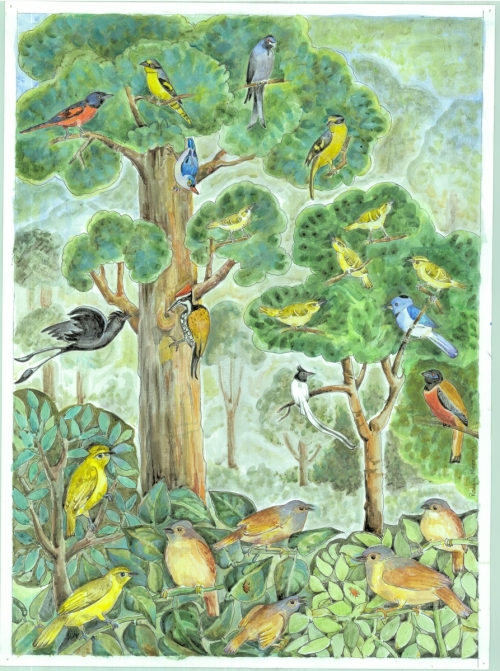I would so much like to see someone using Hari Sridhar, Ferenc Jordán and Kartik Shankers paper “Species importance in a heterospecific foraging association network” as a basis for a study of humans on cocktail parties. Which small groups may be the core of highly important individuals (instead of species)? Is the same group of people important if they go to a party in another place? Or to a scientific conference in another research area? Or are humans not at all like birds?
Here is Hari’s background story to the study. The beautiful drawing is made by Rangu Narayan.
Chance and luck played a big part in the making of this paper. It was early 2008, and I had just begun my doctoral work on mixed-species bird flocks, when Ferenc visited my department. Ferenc specializes in using network approaches to tackle problems in ecology. In a talk during his visit, he mentioned that ‘network thinking’ was particularly useful in two ecological contexts: (1) to understand interactions among individuals in animal social groups (2) to understand interactions among species in communities, e.g. foodwebs. When we heard this, both Kartik (my PhD supervisor) and I immediately realized the value of network thinking in my doctoral work because mixed-species flocks fit both the contexts that Ferenc highlighted. Each mixed-species flock is a social group built on interactions among individuals of different species; but across multiple such flocks in an area, populations of species are linked in a community-level species interaction network. We spoke to Ferenc and he readily agreed to help us, since he too was keen on trying his hand at a new ecological system. Given our different geographical locations (Ferenc was based in Trento, Italy, and Kartik and I in Bangalore, India), the plan was to work the collaboration entirely over email. But another lucky break meant that I could go to Ferenc’s institute in Italy to work on the project. My fieldwork was supported by a grant from the International Foundation for Science (IFS), of which a large portion remained unused till the end. IFS allowed me to use this money to travel to Italy for two weeks in early 2012. Over endless cups of coffee and food at an Indian (!) restaurant in Trento, Ferenc and I built and analysed the flock networks for this paper.
This collaboration had other useful spinoffs. Ferenc came back to India in 2012 to conduct a network analysis workshop as part of a student conservation conference in Bangalore that Kartik and I were involved in organizing. Kartik and Ferenc are also putting together a special issue on ecological networks for a conservation magazine called Current Conservation, which will include a non-technical piece based on this Oikos paper.



The comparison of human cocktail parties to mixed-species bird flocks is quite interesting! the observed cooperation in mixed-species bird flocks, and other such mixed-species grouping only show that nature need not always be red in tooth and claw, and that perhaps cooperation rather than competition could be a stronger driving force in many hitherto unknown interactions [and we know cocktails parties are successful and enjoyable only if people cooperate more:-)] I wonder if parabiotic interactions between ant species could also be treated as such mixed-species cooperative interactions, as these ants pretty much seem to interact similarly.
By: joyshree chanam on March 9, 2013
at 3:33 am